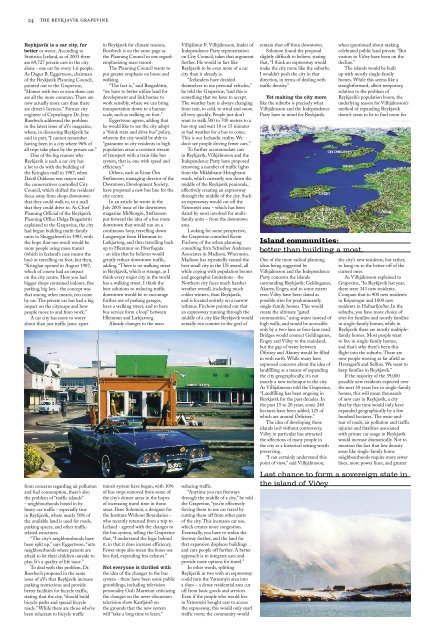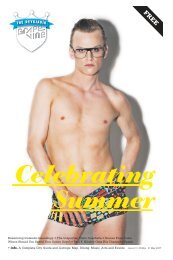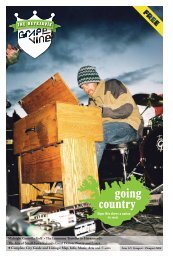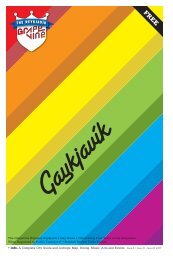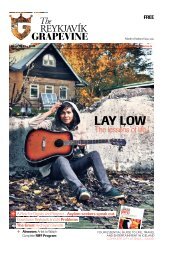7 august - The Reykjavik Grapevine
7 august - The Reykjavik Grapevine
7 august - The Reykjavik Grapevine
Create successful ePaper yourself
Turn your PDF publications into a flip-book with our unique Google optimized e-Paper software.
24<br />
Reykjavík is a car city, for<br />
better or worse. According to<br />
Statistics Iceland, as of 2003 there<br />
are 69,727 private cars in the city<br />
alone - one car for every 1.6 people.<br />
As Dagur B. Eggertsson, chairman<br />
of the Reykjavík Planning Council,<br />
pointed out to the <strong>Grapevine</strong>,<br />
“Homes with two or even three cars<br />
are all the more common. <strong>The</strong>re are<br />
now actually more cars than there<br />
are driver’s licences.” Former city<br />
engineer of Copenhagen Dr. Jens<br />
Roerbech addressed the problem<br />
in the latest issue of aVs magazine,<br />
where, in discussing Reykjavík he<br />
said in part, “I cannot remember<br />
having been in a city where 96% of<br />
all trips take place by the private car.”<br />
One of the big reasons why<br />
Reykjavík is such a car city has<br />
a lot to do with the building of<br />
the Kringlan mall in 1987, when<br />
Davíð Oddsson was mayor and<br />
the conservatives controlled City<br />
Council, which shifted the residents’<br />
focus away from shops downtown<br />
that they could walk to, to a mall<br />
that they could drive to. As Chief<br />
Planning Official of the Reykjavík<br />
Planning Office Helga Bragadóttir<br />
explained to the <strong>Grapevine</strong>, the city<br />
had begun building multi-family<br />
units in Skuggahverfi in 1985, with<br />
the hope that one result would be<br />
more people using mass transit<br />
(which in Iceland’s case means the<br />
bus) or travelling on foot, but then,<br />
“Kringlan opened in August 1987,<br />
which of course had an impact<br />
on the city centre. Here you had<br />
bigger shops contained indoors, free<br />
parking, big lots - the concept was<br />
that among other means, you come<br />
by car. <strong>The</strong> private car has had a big<br />
impact on the cityscape and how<br />
people move to and from work.”<br />
A car city has more to worry<br />
about than just traffic jams: apart<br />
from concerns regarding air pollution<br />
and fuel consumption, there’s also<br />
the problem of “traffic islands”<br />
- neighbourhoods boxed in by<br />
heavy car traffic - especially true<br />
in Reykjavík, where nearly 50% of<br />
the available land is used for roads,<br />
parking spaces, and other traffic-<br />
related structures.<br />
“<strong>The</strong> city’s neighbourhoods have<br />
been split up,” says Eggertsson, “into<br />
neighbourhoods where parents are<br />
afraid to let their children outside to<br />
play. It’s a quality of life issue.”<br />
To deal with this problem, Dr.<br />
Roerbech proposed in the same<br />
issue of aVs that Reykjavík increase<br />
parking restrictions and provide<br />
better facilities for bicycle traffic,<br />
stating that the city, “should build<br />
bicycle paths and special bicycle<br />
roads.” While there are those who’ve<br />
been reluctant to bicycle traffic<br />
in Reykjavík for climate reasons,<br />
Roerbech is on the same page as<br />
the Planning Council in one regard:<br />
emphasizing mass transit.<br />
<strong>The</strong> Planning Council wants to<br />
put greater emphasis on buses and<br />
walking.<br />
“<strong>The</strong> fact is,” said Bragadóttir,<br />
“we have to better utilize land for<br />
development and link homes to<br />
work sensibly, where we can bring<br />
transportation down to a human<br />
scale, such as walking on foot.”<br />
Eggertsson agrees, adding that<br />
he would like to see the city adopt<br />
a “think train and drive bus” policy,<br />
wherein the city would be able to<br />
“guarantee to city residents in high<br />
population areas a constant stream<br />
of transport with a train-like bus<br />
system, that is, one with speed and<br />
efficiency.”<br />
Others, such as Einar Örn<br />
Stefánsson, managing director of the<br />
Downtown Development Society,<br />
have proposed a new bus line for the<br />
city centre.<br />
In an article he wrote in the<br />
July 2005 issue of the downtown<br />
magazine Miðborgin, Stefánsson<br />
put forward the idea of a bus route<br />
downtown that would run on a<br />
continuous loop, travelling down<br />
Laugavegur from Hlemmur to<br />
Lækjartorg, and then travelling back<br />
up to Hlemmur on Hverfisgata<br />
- an idea that he believes would<br />
greatly reduce downtown traffic,<br />
adding, “<strong>The</strong>re is no walking street<br />
in Reykjavík, which is strange, as I<br />
think every major city in the world<br />
has a walking street. I think the<br />
best solutions to reducing traffic<br />
downtown would be to encourage<br />
further use of parking garages,<br />
have a walking street, and to have<br />
bus service form a loop” between<br />
Hlemmur and Lækjartorg.<br />
Already changes to the mass<br />
transit system have begun, with 10%<br />
of bus stops removed from some of<br />
the city’s denser areas in the hopes<br />
of increasing travel time in those<br />
areas. Ilene Solomon, a designer for<br />
the Institute Without Boundaries -<br />
who recently returned from a trip to<br />
Iceland - agreed with the changes to<br />
the bus system, telling the <strong>Grapevine</strong><br />
that, “I understand the logic behind<br />
it, in that it does increase efficiency.<br />
Fewer stops also mean the buses use<br />
less fuel, expending less exhaust.”<br />
Not everyone is thrilled with<br />
the idea of the changes to the bus<br />
system - there have been some public<br />
grumblings, including television<br />
personality Gísli Marteinn criticizing<br />
the changes on the news-discussion<br />
television show Kastljósið on<br />
the grounds that the new system<br />
will “take a long time to learn.”<br />
Vilhjálmur Þ. Vilhjálmsson, leader of<br />
Independence Party representation<br />
on City Council, takes that argument<br />
further. He would in fact like<br />
Reykjavík to be even more of a car<br />
city than it already is.<br />
“Icelanders have decided<br />
themselves to use personal vehicles,”<br />
he told the <strong>Grapevine</strong>, “and this is<br />
something that we have to accept.<br />
<strong>The</strong> weather here is always changing<br />
from rain, to cold, to wind and snow,<br />
all very quickly. People just don’t<br />
want to walk 500 to 700 metres to a<br />
bus stop and wait 10 or 15 minutes<br />
in bad weather for a bus to come.<br />
This is our Icelandic reality. We<br />
don’t see people driving fewer cars.”<br />
To further accommodate cars<br />
in Reykjavík, Vilhjálmsson and the<br />
Independence Party have proposed<br />
removing a number of traffic lights<br />
from the Miklabraut-Hringbraut<br />
roads, which currently run down the<br />
middle of the Reykjavík peninsula,<br />
effectively creating an expressway<br />
through the middle of the city. Such<br />
an expressway would cut off the<br />
Vatnsmýri area – which has been<br />
slated by most involved for multifamily<br />
units – from the downtown<br />
area.<br />
Looking for some perspective,<br />
the <strong>Grapevine</strong> consulted Kevin<br />
Firchow, of the urban planning<br />
consulting firm Schreiber Anderson<br />
Associates in Madison, Wisconsin.<br />
Madison has repeatedly earned the<br />
best small city in the US award, all<br />
while coping with population booms<br />
and geographic limitations - the<br />
Northern city faces much harsher<br />
weather overall, including much<br />
colder winters, than Reykjavík,<br />
and is located entirely on a narrow<br />
isthmus. Firchow pointed out that<br />
an expressway running through the<br />
middle of a city like Reykjavík would<br />
actually run counter to the goal of<br />
reducing traffic.<br />
“Anytime you run freeways<br />
through the middle of a city,” he told<br />
the <strong>Grapevine</strong>, “you’re effectively<br />
forcing them to use car travel by<br />
cutting them off from other parts<br />
of the city. This increases car use,<br />
which creates more congestion.<br />
Eventually, you have to widen the<br />
freeway further, and the land for<br />
that expansion displaces buildings<br />
and cuts people off further. A better<br />
approach is to integrate uses and<br />
provide more options for travel.”<br />
In other words, splitting<br />
Reykjavík in two with an expressway<br />
could turn the Vatnsmýri area into<br />
a slum – a dense residential area cut<br />
off from basic goods and services.<br />
Even if the people who would live<br />
in Vatnsmýri bought cars to access<br />
the expressway, this would only snarl<br />
traffic more; the community would<br />
remain shut off from downtown.<br />
Solomon found the proposal<br />
slightly difficult to believe, stating<br />
that, “I think an expressway would<br />
make the city more like the suburbs.<br />
I wouldn’t push the city in that<br />
direction, in terms of dealing with<br />
traffic density.”<br />
Yet making the city more<br />
like the suburbs is precisely what<br />
Vilhjálmsson and the Independence<br />
Party have in mind for Reykjavík.<br />
Island communities:<br />
better than building a moat.<br />
One of the more radical planning<br />
ideas being suggested by<br />
Vilhjálmsson and the Independence<br />
Party concerns the islands<br />
surrounding Reykjavík: Geldinganes,<br />
Akurey, Engey, and to some extent<br />
even Viðey have been slated as<br />
possible sites for predominantly<br />
single-family homes. This would<br />
create the ultimate “gated<br />
communities,” using water instead of<br />
high walls, and would be accessible<br />
only by a two-lane or four-lane road.<br />
Bridges would connect Geldinganes,<br />
Engey and Viðey to the mainland,<br />
but the gap of water between<br />
Öfirisey and Akurey would be filled<br />
in with earth. While many have<br />
expressed concerns about the idea of<br />
landfilling as a means of expanding<br />
the city geographically, it’s not<br />
exactly a new technique to the city.<br />
As Vilhjálmsson told the <strong>Grapevine</strong>,<br />
“Landfilling has been ongoing in<br />
Reykjavík for the past decades. In<br />
the past 15 to 20 years, some 240<br />
hectares have been added, 125 of<br />
which are around Örfirisey.”<br />
<strong>The</strong> idea of developing these<br />
islands isn’t without controversy.<br />
Viðey in particular has attracted<br />
the affections of many people in<br />
the city as a historical setting worth<br />
preserving.<br />
“I can certainly understand this<br />
point of view,” said Vilhjálmsson,<br />
when questioned about making<br />
celebrated public land private. “But<br />
visitors to Viðey have been on the<br />
decline.”<br />
<strong>The</strong> islands would be built<br />
up with mostly single-family<br />
homes. While this seems like a<br />
straightforward, albeit temporary,<br />
solution to the problem of<br />
Reykjavík’s population boom, the<br />
underlying reason for Vilhjálmsson’s<br />
method of expanding Reykjavík<br />
doesn’t seem to be to find room for<br />
the city’s new residents, but rather,<br />
to hang on to the better-off of the<br />
current ones.<br />
As Vilhjálmsson explained to<br />
<strong>Grapevine</strong>, “In Reykjavík last year,<br />
there were 343 new residents.<br />
Compare that to 900 new residents<br />
in Kópavogur and 1000 new<br />
residents in Hafnarfjörður. In the<br />
suburbs, you have more choice of<br />
sites for families and mostly families<br />
in single-family homes, while in<br />
Reykjavík there are mostly multiplefamily<br />
homes. Most people want<br />
to live in single-family homes,<br />
and that’s why there’s been this<br />
flight into the suburbs. <strong>The</strong>re are<br />
now people moving as far afield as<br />
Hveragerði and Selfoss. We want to<br />
keep families in Reykjavík.”<br />
If the majority of the 39,000<br />
possible new residents expected over<br />
the next 30 years live in single-family<br />
homes, this will mean thousands<br />
of new cars in Reykjavík, a city<br />
that by that time would only have<br />
expanded geographically by a few<br />
hundred hectares. <strong>The</strong> wear-andtear<br />
of roads, air pollution and traffic<br />
injuries and fatalities associated<br />
with private car usage in Reykjavík<br />
would increase dramatically. Not to<br />
mention the fact that low density<br />
areas like single-family home<br />
neighbourhoods require more sewer<br />
lines, more power lines, and greater<br />
Last chance to form a sovereign state in<br />
the island of Viðey


